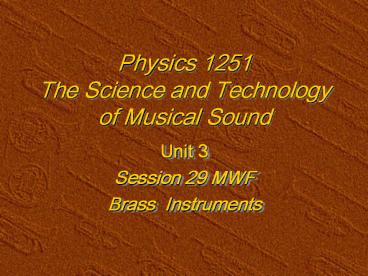Physics 1251 The Science and Technology of Musical Sound - PowerPoint PPT Presentation
Title:
Physics 1251 The Science and Technology of Musical Sound
Description:
What pitch (frequency) does a clarinet play if the length from the ... Louis Armstrong trumpet (1901-1971) Physics 1251 Unit 3 Session 29. Brass Instruments ... – PowerPoint PPT presentation
Number of Views:161
Avg rating:3.0/5.0
Title: Physics 1251 The Science and Technology of Musical Sound
1
Physics 1251The Science and Technology of
Musical Sound
- Unit 3
- Session 29 MWF
- Brass Instruments
2
Physics 1251 Unit 3 Session 29 Brass
Instruments
- What pitch (frequency) does a clarinet play if
the length from the reed to a hole is 19.5 cm
(including end corrections, i.e. L' 0.195 m) at
20 C?
f v/4L' for a stopped cylinder v 343
m/s f 343/(4 ? 0.195) 440 Hz.
3
Physics 1251 Unit 3 Session 29 Brass
Instruments
- 1' Lecture
- Brass instruments are stopped pipes, that have a
bore that is a combination of cylindrical and
conical or flared. - Brass are excited by lip-valves.
- The pitch is determined by feedback from the
resonances of the pipe. - The pitch is changed by exciting various
overtones and by changing the length of the pipe.
4
Physics 1251 Unit 3 Session 29 Brass
Instruments
- Brass Instruments of the Orchestra
Euphonium
Piccolo Trumpet
Trumpet
Trombone
French Horn
5
Physics 1251 Unit 3 Session 29 Brass
Instruments
- Brass Instruments
- The lips produce a pulsation in the pressure
admitted to the pipe the pressure standing wave
feeds back to control the oscillations of the
plays lips.
Lip-valve pulsations
Standing wave frequencies
Feedback
6
Physics 1251 Unit 3 Session 29 Brass
Instruments
- The Origins of Brass
Shofar
Sackbut
Serpent
Ocleidex
7
Physics 1251 Unit 3 Session 29 Brass
Instruments
- The Lip Valve
- 80/20Brass instruments are played by the players
lips. - Breath pressure, muscle tension and pressure
feedback from the pipe determine the frequency of
the opening and closing of the lips.
Louis Armstrong trumpet (1901-1971)
8
Physics 1251 Unit 3 Session 29 Brass
Instruments
- Lip Valve
Embouchure
9
Physics 1251 Unit 3 Session 29 Brass
Instruments
- Lip Valve
- The lips of the player act as a valve that admits
pressure pulses into the pipe. - The frequency is determined by the breath air
pressure, the lip tension and the resonances of
the pipe.
10
Physics 1251 Unit 3 Session 29 Brass
Instruments
- 80/20Brass Instruments
- are stopped pipes.
- The players lips produce a
displacement node
(pressure antinode)
at the mouthpiece. - A displacement
anti-node (pressure node)
exists at the bell.
Winton Marsalis Trumpet
11
Physics 1251 Unit 3 Session 29 Brass
Instruments
- The Mouthpiece
Back Bore
Cup
12
Physics 1251 Unit 3 Session 29 Brass
Instruments
- The Mouthpiece
Cup Volume
80/20The Cup Volume and the diameter of the
constriction leading to the back bore are more
important than the shape of the cavity.
Diameter
13
Physics 1251 Unit 3 Session 29 Brass
Instruments
- Resonance for Combination Pipes
80/20The Brass mouthpiece lowers the high
frequency resonances.
f
Cone with mouthpiece
Cone
14
Physics 1251 Unit 3 Session 29 Brass
Instruments
- The pitch is changed by pipe length and
excitation of resonances.
By means of slides and valves the length is
changed.
15
Physics 1251 Unit 3 Session 29 Brass
Instruments
16
Physics 1251 Unit 3 Session 29 Brass
Instruments
- Horns can be played by exciting the
resonances only.
The Natural Horns No valves
17
Physics 1251 Unit 3 Session 29 Brass
Instruments
- Resonance for Combination Pipes
f
Cone/ Cylinder
0/100
25/75
50/50
40/60
20/80
100/0
18
Physics 1251 Unit 3 Session 29 Brass
Instruments
- Resonances for Combination Bores
in Brass Instruments - 80/20A 50 cylindrical ? 50 conical bore has a
nearly harmonic series.
19
Physics 1251 Unit 3 Session 29 Brass
Instruments
- Cylindrical-Conical Instruments
Cone
French Horn
Trombone
Cylinder
Cornet
20
Physics 1251 Unit 3 Session 29 Brass
Instruments
- Trumpet-like Instruments
Various instruments have different lengths of
cylindrical and of conical pipe.
21
Physics 1251 Unit 3 Session 29 Brass
Instruments
- The Bell
Exponential Horn
a ao exp(m x) b
80/20m is called the
flare constant. Larger m means more rapid flare.
22
Physics 1251 Unit 3 Session 29 Brass
Instruments
- The Bell
Bessel Horns
a ao e-(ex) b
80/20Called Bessel Horns because the standing
wave follows a Bessel Function.
23
Physics 1251 Unit 3 Session 29 Brass
Instruments
- Summary
- Brass Instruments are stopped pipes.
- The pipe bore is designed to give resonances that
are harmonic. - The pedal tone (the lowest note) is not harmonic.
- The players lips are a soft reed.
- The pitch is changed by changing the length and
exciting resonances.

